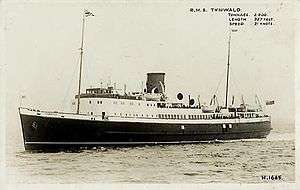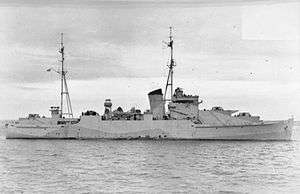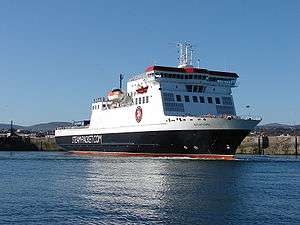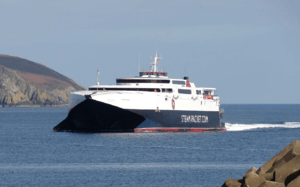SS Tynwald (1936)
 RMS Tynwald | |
| History | |
|---|---|
| Name: | Tynwald |
| Owner: | 1936–1940: Isle of Man Steam Packet Company |
| Operator: | Isle of Man Steam Packet Company |
| Port of registry: |
|
| Ordered: | 1936 |
| Builder: | Vickers-Armstrong, Barrow-in-Furness, United Kingdom |
| Laid down: | 1935 |
| Launched: | 16 December 1936 |
| Completed: | 1937 |
| In service: | 1937 |
| Out of service: | Transferred to the Royal Navy as HMS Tynwald, late 1940 |
| Homeport: | Douglas, Isle of Man |
| Identification: |
|
 HMS Tynwald | |
| Name: | HMS Tynwald |
| Commissioned: | 1 October 1941 |
| Fate: | Sunk on 12 November 1942 |
| Status: | War Grave |
| General characteristics | |
| Type: | Passenger steamer |
| Tonnage: | 2,375.53 GRT |
| Length: | 314 ft 6 in (95.9 m) |
| Beam: | 46 ft (14.0 m) |
| Depth: | 18 ft (5.5 m) |
| Installed power: | 8,500 shp (6,300 kW) |
| Propulsion: |
|
| Speed: | 21.7 knots (25.0 mph) |
| Capacity: | 1968 passengers |
| Crew: | 68 |
TSS (RMS) Tynwald No. 165281 was a passenger vessel which served with the Isle of Man Steam Packet Company from 1937 until she was requisitioned for war service at the end of 1940. She was the fourth ship in the line's history to bear the name. Tynwald was sunk in November 1942 off the Algerian coast.


Design and construction
Tynwald and her identical twin Fenella were built by Vickers Armstrong at Barrow-in-Furness and launched on the same day, 16 December 1936.
Tynwald had a gross registered tonnage of 2376t, a beam of 46', a length of 314'6", a draught of 18' and a design speed of 21 knots. Both Tynwald and Fenella, had crew accommodation for 68, and a capacity for 1968 passengers.
Steam Packet Company service
Like her sister ship Fenella, Tynwald was intended primarily to be used on the winter service between Liverpool and Douglas.
They were virtually identical apart from slight decorative differences, the noticeable external difference being Tynwald had her upper strake painted white, whereas on Fenella it was black. Spacious lounges were a feature of both ships which were furnished to a high standard.
On 1 October 1937, the Tynwald conveyed the newly appointed Lieutenant Governor of the Isle of Man, Vice Admiral Leveson-Gower from Liverpool to Douglas.[1] The Tynwald was decorated with bunting and flew the Governor's flag from the foremast. She arrived into Douglas at 14:45hrs, signalling her arrival by the blowing of her ship's whistle, which in turn was greeted by rockets being fired from Douglas Head and the sounding of the fog horn on the Victoria Pier.[1]
On 17 November 1937, during a storm with associated south-easterly gales, Tynwald sustained damage whilst attempting to berth at Douglas. Earlier that day, her sister Fenella had fouled a mooring rope whilst also attempting to berth at Douglas, which prior to the construction of the Princess Alexandra Pier in 1984, was a notoriously hazardous port due to its exposure during periods of strong easterly wind. Taking that morning's sailing from Liverpool to Douglas, Tynwald experienced great difficulty trying to berth at the King Edward VIII Pier, and suffered damage to the belting on her starboard side, over a distance of approximately five metres, as well as suffering damage to her plating.[2] Finally she secured alongside and having discharged her passengers and mail, Tynwald departed for Liverpool at 15:50hrs taking the passengers and mail which should have left on Fenella's morning sailing, which had been cancelled due to her incident with the mooring rope.[2]
War service
Along with Fenella, Tynwald was requisitioned as a personnel vessel in the first week of the war. Her log was largely uneventful until with the German onslaught on Belgium and France during the spring of 1940, the plight of the British Expeditionary Force became apparent, and she was dispatched to assist with the evacuation of troops from Dunkirk.
During the course of Operation Dynamo, Tynwald, initially under the command of Captain J H Whiteway, and then under Captain W A Qualtrough, had the distinction of embarking more troops that any other company vessel.[3]
She made her first mission to the shattered port on 28 May, and was one of ten personnel ships that lifted a total of 14,760 troops from the eastern mole the following day. The same day, her sister Fenella was lost.
In the late evening of 30 May, she was one of four personnel vessels back at the mole and withdrew 1,153 troops. On 2 June, she made her third trip and embarked 1,200 troops, leaving for Dover in the early morning of 3 June.
The last day of the operation was 4 June; shortly after 14:00hrs, the Admiralty announced that Operation Dynamo was over. By then Tynwald had already left the eastern mole after her fourth trip. She was the last ship to leave, landing 3,000 French troops in England later that day. Her total in the operation is officially given as 8,953 troops.
Royal Navy service - HMS Tynwald

At the end of 1940, she was compulsorily acquired, fitted out as an auxiliary anti-aircraft ship and commissioned as HMS Tynwald on 1 October 1941. Armed with 6 4" AA guns (3X2), and 8 2-Pdr AA guns (2X4). After a year on convoy escort duties around Britain she was assigned to Operation Torch, the Allied landing in North Africa, and was involved in the attack on Algiers on 8 November 1942.
Three days later the ship was part of a task force sent to capture an airfield near Bougie (modern Béjaïa) 100 miles east of Algiers. At the centre of the force were infantry landing craft, and the covering force included the cruiser HMS Sheffield, the monitor HMS Roberts, Tynwald and fourteen other supporting vessels. The first landing met with little or no opposition, and the Bougie harbour was occupied. However, it proved impossible to capture the airfield from the sea owing to adverse weather conditions. Instead, the attacking force that was still at sea came under heavy enemy air attack in the Battle of Béjaïa.
Fate
On 12 November 1942, Tynwald was hit by a torpedo fired by the Italian submarine, Argo.[4] She had been standing by the monitor Roberts, which was on fire and badly damaged. Tynwald went down in 7 fathoms (13 m) of water,[5] her wreck position is given as LAT:36°51'N LON:005°04'E.[6]
Survivors were rescued by Roberts and the corvette HMS Samphire. Three officers and seven ratings were listed as casualties.
Footnotes
- 1 2 Peel City Guardian; Date:9 Oct 1937
- 1 2 Peel City Guardian; Date:20 Nov 1937; Section:Front page; Page Number:1
- ↑ "Manx Lifeline". Kneen Family. Retrieved 2013-08-04.
- ↑ "Regia Marina Italiana". Cristiano D'Adamo. Retrieved 2012-08-10.
- ↑ "HMS Tynwald - anti-aircraft ship". U-Boat.net.
- ↑ http://www.wrecksite.eu/wreck.aspx?96366

